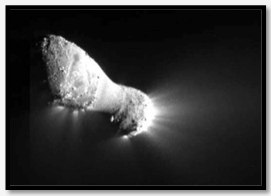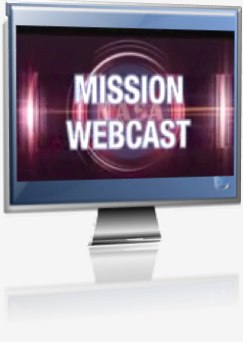
Link to the IceBridge Mission page.

Link to the IceBridge Mission page.
 During this installment of NASA Now, NASA senior research engineer Judith Watson describes the project she’s currently working on. She’s one of a team of engineers at NASA’s Langley Research Center who are studying inflatable structures that might one day be used to establish an outpost on the moon or Mars.
During this installment of NASA Now, NASA senior research engineer Judith Watson describes the project she’s currently working on. She’s one of a team of engineers at NASA’s Langley Research Center who are studying inflatable structures that might one day be used to establish an outpost on the moon or Mars.
 Spaced Out Sports is a national student design challenge for students in grades 5-8. The purpose is for students to apply Newton’s Laws of Motion to designing or redesigning a game for International Space Station astronauts to play in space. As students design a new sport, they learn about Newton’s Laws of Motion and the effect of gravity on an object. They predict the difference between a game or activity played on Earth and in the microgravity environment of the ISS.
Spaced Out Sports is a national student design challenge for students in grades 5-8. The purpose is for students to apply Newton’s Laws of Motion to designing or redesigning a game for International Space Station astronauts to play in space. As students design a new sport, they learn about Newton’s Laws of Motion and the effect of gravity on an object. They predict the difference between a game or activity played on Earth and in the microgravity environment of the ISS. Link to the NES Virtual Campus website.

For more information about EPOXI and to see the stunning pictures of Comet Hartley 2 visit https://www.nasa.gov/epoxi.
 Someday YOU may one of the people to walk around on Mars. That’s some day in the future — way in the future. But here’s your chance to have a presence on Mars soon! Send your name to Mars! Your name will be included with others on a microchip attached to the rover, Curiosity. Launch is scheduled for between Nov. 25 and Dec. 18, 2011, with a Martian arrival date of August 2012.
Someday YOU may one of the people to walk around on Mars. That’s some day in the future — way in the future. But here’s your chance to have a presence on Mars soon! Send your name to Mars! Your name will be included with others on a microchip attached to the rover, Curiosity. Launch is scheduled for between Nov. 25 and Dec. 18, 2011, with a Martian arrival date of August 2012.
 In one of its final mission trajectory correction maneuvers, the EPOXI mission spacecraft has refined its orbit, preparing it for the flyby of comet Hartley 2 on Nov. 4. The time of closest approach to the comet on that day is expected to be about 7:02 a.m. PDT.
In one of its final mission trajectory correction maneuvers, the EPOXI mission spacecraft has refined its orbit, preparing it for the flyby of comet Hartley 2 on Nov. 4. The time of closest approach to the comet on that day is expected to be about 7:02 a.m. PDT.
A Nov. 3 trajectory correction maneuver began at 11 a.m. PDT, when the spacecraft burned its engines for 60 seconds, changing its velocity by 1.59 meters per second.
On Nov. 4, the spacecraft will fly past Hartley 2 at a distance of about 700 kilometers (435 miles). It will be only the fifth time in history that a spacecraft has been close enough to image a comet’s nucleus.
EPOXI is an extended mission that uses the already “in-flight” Deep Impact spacecraft to explore distinct celestial targets of opportunity. The name EPOXI itself is a combination of the names for the two extended mission components: the extrasolar planet observations, called Extrasolar Planet Observations and Characterization (EPOCh); and the flyby of comet Hartley 2, called the Deep Impact Extended Investigation (DIXI). The spacecraft will continue to be referred to as “Deep Impact.”
For more information about EPOXI, visit the mission website.
Click here see some spectacular video about the EPOXI/Hartley 2 encounter.
Link to the NES Virtual Campus website.
 During this unique episode of NASA Now, astronaut and veteran spacewalker Mike Foreman describes his experiences from liftoff to living and working in space. He was selected to be an astronaut in 1998. He flew on space shuttle Endeavour in March 2008, and he returned to the station on space shuttle Atlantis in November 2009. Foreman has logged over 637 hours in space, with over 32 of those hours in a spacesuit during five spacewalks.
During this unique episode of NASA Now, astronaut and veteran spacewalker Mike Foreman describes his experiences from liftoff to living and working in space. He was selected to be an astronaut in 1998. He flew on space shuttle Endeavour in March 2008, and he returned to the station on space shuttle Atlantis in November 2009. Foreman has logged over 637 hours in space, with over 32 of those hours in a spacesuit during five spacewalks.
 Discovery will carry a crew of six to and from the space station – Lindsey, Pilot Eric Boe, and Mission Specialists Alvin Drew, Tim Kopra, Michael Barratt and Nicole Stott – as well as what used to be the Leonardo Multipurpose Module on a one-way trip. It’s now called the Permanent Multipurpose Module, and rather than returning, it will stay attached to the station’s Unity node to provide extra storage for the space station. And though the concept of a closet in space may not sound too exciting, it’s becoming more important all the time.
Discovery will carry a crew of six to and from the space station – Lindsey, Pilot Eric Boe, and Mission Specialists Alvin Drew, Tim Kopra, Michael Barratt and Nicole Stott – as well as what used to be the Leonardo Multipurpose Module on a one-way trip. It’s now called the Permanent Multipurpose Module, and rather than returning, it will stay attached to the station’s Unity node to provide extra storage for the space station. And though the concept of a closet in space may not sound too exciting, it’s becoming more important all the time. 
Date and time to be determined, based on the STS-133 launch schedule: Join hosts Damon Talley and Rachel Power LIVE onthe Web from NASA’s Kennedy Space Center for the launch of STS-133 and learnabout the mission and crew.
Theshuttle Discovery’s mission will carry Robonaut 2, the Permanent MultipurposeModule, and the Express Logistics Carrier 4 to the International Space Station.STS-133 will be the 35th shuttle mission to the station.
Submitquestions, both leading up to and during the LaunchCast, at nasalearn@gmail.com. Questions will be answered during the live webcast!
Towatch the webcast, go to http://dln.nasa.gov/dlnapp/webcast/webcast.do.
To get the latest information about the launch and progress of STS-133, visit the mission website.
Link to the NES Virtual Campus website.
Today, NASA celebrate ten years of humans living and working continuously aboard the International Space Station. This global milestone is tremendously significant, both for NASA and our partners. It recognizes the success of an amazing feat of engineering and a magnificent leap forward in the story of human achievement. I congratulate the entire station team and the thousands of people worldwide who have helped us reach this anniversary.
Since Bill Shepherd, Yuri Gidzenko and Sergei Krikalev first boarded the station as the Expedition 1 crew, more than 196 people have visited the complex, and by the exact time of the anniversary this morning, the station will have completed 57,361 orbits of Earth, traveling some 1.5 billion miles.
More than 600 different research and technology development experiments have been conducted on the station, many of which are producing advances in medicine, recycling systems and a fundamental understanding of the universe. On Oct. 25, the station set a record for being the longest continuously inhabited spacecraft. On that day, the space station eclipsed the previous record of 3,644 days set by the Russian Mir Space Station. The station is our toehold in space, and it will be an essential part of our work to send humans on missions beyond low Earth orbit in the future.
With passage of the NASA Authorization bill, we will now be able to extend the life of the station to at least 2020. Representatives of the five international agencies that built and operate the outpost have also agreed on this in principle. Indeed, one of the station’s greatest legacies is the international partnerships we have forged to create something awe-inspiring that benefits people all over the world. Partnerships with other nations will be essential to the global exploration enterprise of the future, and with each new day, NASA and its partners are pushing the envelope of human achievement in space into uncharted territory.
On board the station right now are six talented and courageous travelers representing NASA and our Russian partners. Tomorrow, the crew of STS-133 is expected to lift off on its way to the International Space Station aboard the last scheduled flight of shuttle Discovery. As we enter the station’s second decade, our path forward will take us deeper into space and expand humanity’s potential farther. The lessons we learn on the station will carry us to Mars and beyond. I want to give a heartfelt thank you to the six crew members on orbit and all the teams over the years that have helped us get to this milestone day.